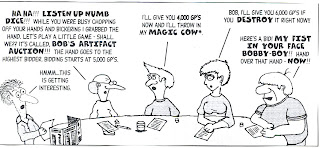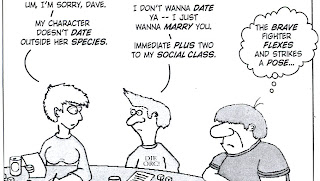
Hoody hoo! The gaming comic book
Knights of the Dinner Table started as a small strip in 1990, and it's still going strong almost 20 years later. If you've ever played
Dungeons and Dragons, or know people who have, you'll love the misadventures of some of the world's worst gamers.
The prime focus of
KODT is a Muncie, Indiana-based group of roleplayers called, well, the Knights of the Dinner Table. Going from left to right in the picture above, the Knights are: B.A. Felton, the frazzled gamemaster who always wants to create an epic adventure and whose campaigns are invariably wrecked by the others; Bob Herzog, the whiny, scrawny smartass with a quick temper; Dave Bozwell, the jock who's ready to slay anything he considers a threat (or experience points); Sara Felton, B.A.'s cousin and the only player interested in acting heroically or altruistically; and Brian van Hoose, the epitome of the rules lawyer who can cite passage and paragraph ver batim -- as long as it backs what he wants.

The Knights' game of choice is
HackMaster, a thinly-veiled version of
D&D that has tons of errors and rewards selfishness, greed, and wanton killing. This fits nicely with the playing style of Bob, Dave and Brian (who dubbed themselves "the Untouchable Trio," since when their characters got killed their new ones were exact copies of the last ones), who have been known to destroy whole towns and slaughter characters that did them no harm (and who B.A. wanted to use to start the adventure).
There's a lot to
KODT besides just the Knights, though. Several other gaming groups are often covered, most notably the Black Hands, a group more explicitly malevolent than the Knights. There's fat old-timer Weird Pete, who runs the local Games Pit gaming store. (In one of many nice touches, the current store has a sign in the window warning "Parents! I'm not yer kids' babysitter!" while in flashbacks a sign proclaims "Parents, I will gladly watch your children while you shop.") There's Hard Eight Enterprises, which publishes
HackMaster (and
SpaceHack, and
Hacknoia, and many other games), and the company's legendary owner/
HackMaster creator Gary Jackson -- who was killed off. A current story has his widow/Hard Eight president Heidi Jackson revamping
HackMaster to be more accessible to new players, while the staff try to stick with the minutia of the old rules. (
D&D 4e vs. older versions, anyone?) And there's even a hyper-intelligent chimp called Squirrely that works for Weird Pete.

The art of
KODT is simplistic -- most faces and bodies are copied from other pics, with an occasional raised arm, costume, or character who got bruised or in a cast providing variety -- which may turn off some readers while adding to the charm for others. The storylines vary from short (plenty of self-contained stories in many issues) campaigns that can go well over a year (such as the Knights' current crawl through the Temple of Horrendous Doom). It's usually a good idea to find the start of a longer story arc before delving in the middle, and all the issues are collected in each
Bundle of Trouble volume.
Oh yes --
KODT is funny. Damn funny. Often laugh-out-loud funny. The Untouchable Trio hear there's a gazebo and, not knowing what it is, engage in an "epic" battle with the creature! The strip I used at the top has the Knights finding a legendary cursed hand, which leads to Dave and Brian trying to cut off their own hand to use it, Sara trying to destroy it, Bob wanting to sell it, and B.A. reminding those hacking at themselves of the hit points they're still losing. A movie discussion had them saying that the Lord of the Rings movies were good, but no
Hawk the Slayer. ("
Hawk rules!") A Dalek appears in Weird Pete's game store. An argument over avoiding starvation by eating Dave's "magic" cow or Bob's "dwarven warhorse" (a mule) has them deciding to each the torch bearer instead. A mission to investigate crop circles in Canada results in a massive gunfight as the Knights' characters try to smuggle a massive arsenal through Customs -- and Dave insists Canada is a Communist country! And the Knights often play different games, taking on such varied ones as
Risk,
Once Upon a Time,
The Settlers of Catan ("I have wood for sheep") and
The Great Space Race.
KODT also resists being a static strip. While the Untouchable Trio spent years playing the same characters -- Bob was the dwarven thief Knuckles ("I waste him with my crossbow!"), Dave was the fighter El Ravager (with a +12 sword), Brian was the mage Teflon Billy ("fireballs coming online") -- recent changes have forced them to play new character types. Weird Pete faces still competition from the new game store in town -- that's run professionally. And right now the future of
HackMaster is in danger (possibly of becoming better) as the old school faces the perils of progress.
Each issue of
KODT has other features, from editorials and letters (including mine, printed so often they now bear the heading "The Lynch Report") to gaming news, characters and articles on
HackMaster (yes, Kenzer & Company
www.kenzerco.com , the folks behind
KODT, actually released a
HackMaster rpg), and even cartoons. For me, the draw is the strips first and foremost. So I highly recommend everyone out there pick up
Knights of the Dinner Table, enjoy the monthly exploits of these gleefully woeful gamers, and join them in their cry of triumph:
HOODY HOO!Overall grade: AReviewed by James Lynch
 If a classic movie gets remade, the new version should add something worthwhile to the original to justify its existence. Rob Zombie's 2007 version of Halloween provides more details on what made Michael Meyers the monster he is; sadly, this Halloween also adds Zombie's excessive gore, profanity, nudity, and horrible examples of humanity.
If a classic movie gets remade, the new version should add something worthwhile to the original to justify its existence. Rob Zombie's 2007 version of Halloween provides more details on what made Michael Meyers the monster he is; sadly, this Halloween also adds Zombie's excessive gore, profanity, nudity, and horrible examples of humanity. The backstory to what makes Michael Meyers tick (and stab) isn't needed. Nor are the gratituous nudity and violence pervasive through this movie, as well as the plethora of characters that are nothing but scumbags. McDowell is good as Loomis, but the rest of the cast is forgettable. And while Michael's collection of masks is a bit disturbing, the excesses here make this substantially inferior to the original. This Halloween, unless you feel like wallowing in gore and depravity skip the new Halloween and go with the original.
The backstory to what makes Michael Meyers tick (and stab) isn't needed. Nor are the gratituous nudity and violence pervasive through this movie, as well as the plethora of characters that are nothing but scumbags. McDowell is good as Loomis, but the rest of the cast is forgettable. And while Michael's collection of masks is a bit disturbing, the excesses here make this substantially inferior to the original. This Halloween, unless you feel like wallowing in gore and depravity skip the new Halloween and go with the original.



































